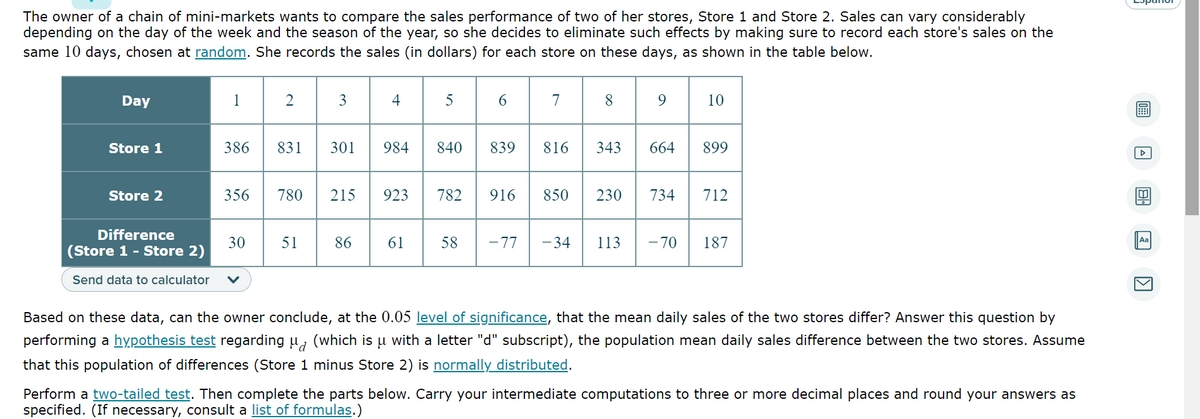The owner of a chain of mini-markets wants to compare the sales performance of two of her stores, Store 1 and Store 2. Sales can vary considerably depending on the day of the week and the season of the year, so she decides to eliminate such effects by making sure to record each store's sales on the same 10 days, chosen at random. She records the sales (in dollars) for each store on these days, as shown in the table below. Day Store 1 Store 2 1 386 831 301 356 780 215 Difference (Store 1 - Store 2) Send data to calculator V 30 51 86 4 984 923 5 840 782 61 58 6 839 916 816 850 8 9 10 343 664 899 230 734 712 -77 -34 113 -70 187 Based on these data, can the owner conclude, at the 0.05 level of significance, that the mean daily sales of the two stores differ? Answer this question by performing a hypothesis test regarding Hd (which is u with a letter "d" subscript), the population mean daily sales difference between the two stores. Assume that this population of differences (Store 1 minus Store 2) is normally distributed. Perform a two-tailed test. Then complete the parts below. Carry your intermediate computations to three or more decimal places and round your answers as specified. (If necessary, consult a list of formulas.)
The owner of a chain of mini-markets wants to compare the sales performance of two of her stores, Store 1 and Store 2. Sales can vary considerably depending on the day of the week and the season of the year, so she decides to eliminate such effects by making sure to record each store's sales on the same 10 days, chosen at random. She records the sales (in dollars) for each store on these days, as shown in the table below. Day Store 1 Store 2 1 386 831 301 356 780 215 Difference (Store 1 - Store 2) Send data to calculator V 30 51 86 4 984 923 5 840 782 61 58 6 839 916 816 850 8 9 10 343 664 899 230 734 712 -77 -34 113 -70 187 Based on these data, can the owner conclude, at the 0.05 level of significance, that the mean daily sales of the two stores differ? Answer this question by performing a hypothesis test regarding Hd (which is u with a letter "d" subscript), the population mean daily sales difference between the two stores. Assume that this population of differences (Store 1 minus Store 2) is normally distributed. Perform a two-tailed test. Then complete the parts below. Carry your intermediate computations to three or more decimal places and round your answers as specified. (If necessary, consult a list of formulas.)
Linear Algebra: A Modern Introduction
4th Edition
ISBN:9781285463247
Author:David Poole
Publisher:David Poole
Chapter2: Systems Of Linear Equations
Section2.4: Applications
Problem 28EQ
Related questions
Question
A. Find the value of the test statistic. (Round to three or more decimal places.)
B. Find the two critical values at the 0.05 level of significance. (Round to three or more decimal places.)
C. At the 0.05 level, can the owner conclude that the mean daily sales of the two stores differ?

Transcribed Image Text:The owner of a chain of mini-markets wants to compare the sales performance of two of her stores, Store 1 and Store 2. Sales can vary considerably
depending on the day of the week and the season of the year, so she decides to eliminate such effects by making sure to record each store's sales on the
same 10 days, chosen at random. She records the sales (in dollars) for each store on these days, as shown in the table below.
Day
Store 1
Store 2
Difference
(Store 1 - Store 2)
Send data to calculator
1
386
2
30
3
831 301
356 780 215
51
86
4
984
923
5
840
6
839
782 916
7
8
850
9
816 343 664 899
10
230 734
712
61 58 -77 -34 113 -70 187
Based on these data, can the owner conclude, at the 0.05 level of significance, that the mean daily sales of the two stores differ? Answer this question by
performing a hypothesis test regarding µ (which is u with a letter "d" subscript), the population mean daily sales difference between the two stores. Assume
that this population of differences (Store 1 minus Store 2) is normally distributed.
Perform a two-tailed test. Then complete the parts below. Carry your intermediate computations to three or more decimal places and round your answers as
specified. (If necessary, consult a list of formulas.)
8
Aa
Expert Solution
This question has been solved!
Explore an expertly crafted, step-by-step solution for a thorough understanding of key concepts.
Step by step
Solved in 5 steps with 2 images

Recommended textbooks for you

Linear Algebra: A Modern Introduction
Algebra
ISBN:
9781285463247
Author:
David Poole
Publisher:
Cengage Learning

Glencoe Algebra 1, Student Edition, 9780079039897…
Algebra
ISBN:
9780079039897
Author:
Carter
Publisher:
McGraw Hill


Linear Algebra: A Modern Introduction
Algebra
ISBN:
9781285463247
Author:
David Poole
Publisher:
Cengage Learning

Glencoe Algebra 1, Student Edition, 9780079039897…
Algebra
ISBN:
9780079039897
Author:
Carter
Publisher:
McGraw Hill
